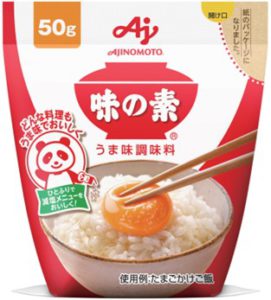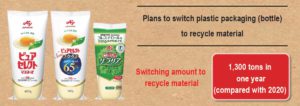News
2022/11/10
Ajinomoto adopts paper packaging in crystalloid Umami seasoning - the first ever in Japan

Ajinomoto Co., Inc. has switched the packaging of “AJI-NO-MOTO” and “Hi-Me”- its pride and longtime best seller from plastic to paper aiming to accomplish its corporate goal of “elimination of plastic wastes by 2030”. The move contributes to reduce 12 tons of plastic waste every year. The new paper packaging keeps the same shape of the current package, which also perform the same functions.
“AJI-NO-MOTO” has the same name of the corporate, it thus symbolizes the annual environmental measures of the corporate
Plastic is becoming a huge environmental concern especially in recent years that more and more people wish to eliminate plastic in their lifetime to change the scenery. Aiming to tackle the issue, Ajinomoto Co., Inc. set its corporate goal as “elimination of plastic wastes by 2030” and looked into the packaging of many of its products. The decision to switch “AJI-NOMOTO” and “Hi-Me” to paper packaging is a big move along the journey to achieve the goal.
“We’ve worked the packaging of a number of our products while opting for paper without changing the product contents is our very first time that we encountered quite a lot of technical problems indeed. Particularly, we are talking about ‘AJI-NO-MOTO’, the product having the same name as our corporate. It’s our longtime seller since our establishment. It’s also the symbol of all our environmental measures of the year, so we need to, at all events, put extra effort on it,” claimed Mr. Fumihiro Miyasaka, who is the manager and in charge of product development in the Umami seasoning group, Seasoning Business Division, Food Business Department of the corporate.
Mr. Miyasaka added that the reason to opt for paper is, “mono-material packaging contributes tremendously to solve environmental issues for its biodegradable and compostable film.
It can be recycled as a new packaging material but unfortunately the provision is behind standard. On the other hand, switching to paper packaging help to reduce plastic wastes to a certain extent that consumers are involved right from the moment of their purchase.
Our resources are limited and they are all coming to their end soon, so we would love to work on environmental issues using renewable materials in the carbon cycle.”
Pinhole-resistance and vapor barrier considerations
Paper is not an easy option due to a string of problems. The paper packaging for hard crystalloid seasoning like “AJI-NO-MOTO” and “Hi-Me” might get torn in the logistics and transportation processes. There are also worries about the sealing ability of paper bags like “water may get in when we touch the paper bag with a wet hand”, “the content may absorb moisture and clump in”, etc. To tackle these problems, the corporate has carried out as many as 20 demonstration tests using 19 available options in total. They eventually came up with an idea of adding functional resin in the inner side of the paper as pinhole-resistance and vapor barrier layer so the content won’t absorb water or moisture. Regarding pinhole-resistance, the new material is 1.4 times more durable than the current plastic one and 2.6 times stronger than other general paper packaging. As a layer of functional resin is added on the current sealable film on the inner side, the paper package is as heat resistant as the current one. The layer structure is, thus, paper, functional resin, then sealable film with over 50% of paper in total.
The adoption of the new package brings about 34% reduction of the current plastic usage (when compared with the current plastic package), so 12 tons of plastic wastes is saved in a year (when compared with 2020).
Rotogravure on the paper surface
Package printing affects how consumers perceive the product, which is the very concerns of every corporate. Ajinomoto adopts rotogravure as general paper printing on package film might easily blur out. Ink may scratch off when the products come into contact with other materials in the transportation process as the printing is merely done on the surface.
“It’s a process of trials and errors,” commented Ms. Miho Higuchi from the Package Design Group of the Product Development Centre of the Food Research Institute, Food Business Department.
“We understand that flexography printing works the best on paper while only a very, very small number of our partners possess such kind of printer to provide the technology. We hence opted for rotogravure this time. Thanks for the effort from our suppliers who tried their best to perfect the paper design, the printing was a miracle.
As for the friction during transport, we looked into the reviews of different paper types and coating agents so as to make sure ink won’t scratch off under normal logistic,” she rejoiced.
Unique pouch with triangular “legs” to stand

on both sides of the package bag
The same “wide top bag” design was successfully kept. The shape is like no other general standing pouches that at the lower external side of the pillow-shape package bag is folded as “legs” to stand alone. They named the package “penguin” for its lovely appearance. The packaging pouch, in fact, only consumes a small amount of material when compared with other standing pouches or cassette pouches come with a gusset- it saves our resources.
“It saves up a huge amount of material but it stands- so we know it’s the one, the paper package functions as excellent as the plastic package bag,”says Ms. Higuchi.
Nonetheless, conventional filling packaging machines had never used paper and had many issues. “The triangular seals of the ‘penguin’ was es- pecially difficult as it’s rigid so paper wrinkles could be a problem when compared with films. As a result, we have to change different parameters of the filling packaging machine to see whether we can sort that out to match with the components. Everything is for realizing the same high productivity of the conventional plastic package,” explained Mr. Yusuke Honda, also from the Package Design Group of the Product Development Centre of the Food Research Institute, Food Business Department.
The production cost for paper packaging is higher while the corporate has chosen not to transfer the cost to their customers. The decision was based on the true, real feedback from consumers. Mr. Miyasaka remarked that customers claimed it’s an absolute “no” when asked whether they found it reasonable to bare the production cost increase due to the new paper packaging option. He said, “It means that our consumers believe that environmental issues are to be dealt by manufacturers; retail price should never be adjusted for that. We hadn’t sacrifice profits for the move, so we had to minimize increase in the production cost through various means like making the package smaller.”
Plans to monomaterialize mayonnaise bottle
As it’s the first paper packaging ever for crystalloid seasoning in Japan, the move had enormous effects on other competitors in the industry, as well as to consumers and to society as a whole. “We sincerely hope social effects will be all positive. It’d be great if we could be the pioneer in this aspect,” commented Mr. Miyasaka. So far, positive feedback has been obtained from large supermarket agents, so the corporate has high hopes on the sales figures.
They are now planning to mono-materialize the packaging of the “Pure Select” mayonnaise series by the end of the fascial year 2022 (excluding the fresh keeping bottles of the “Pure Select Mayonnaise”). The move involves as much as 1,300 tons of recycle materials when compared with 2020. They are also working on the switch from plastic to paper packaging for their sweetener “Pal Sweet Slim-up Sugar” (20-piece bag stick) to cut off the use of 1 tons of plastic in a year. Concerning with overseas products, Ajinomoto Indonesia has cut off the header in the package of “Masako”, its major product, and Ajinomoto
Thailand has abolished the inner package of “AJI-NO-MOTO”. It’s estimated that the usage of as many as 864 tons of plastic could be reduced in every year (when compared to fascial year 2019) among all Ajinomoto products in the four regions of Indonesia, Thailand, Philippines, and Vietnam.
To conclude, let’s take a deeper look at the comment from Mr. Kosuke Usui, the chief research officer from the Package Design Group of the Product Development Centre of the Food Research Institute, Food Business Department in preparation for the goal of “elimination of plastic wastes by 2030”-.
“We have three major concrete plans indeed. The first one is to light, thin, and small. As it goes literally, we would like to make our package lighter, thinner, and smaller. The paper packaging this time is a part of this plan. The second one is to adopt recycle materials, including mono-materials, which is actually the area with the brightest spotlight for future technologies. We are very much ready to work with material manufacturers and convertors for new development hand in hand. The third one is biodegradable resin. Regarding this, we are evaluating the adoption considering the development plan of recycling infrastructure. Certainly we are keeping a close eye on trends, including overseas trends.”
* “AJI-NO-MOTO” and “Hi-Me” are registered trademarks of Ajinomoto Co., Inc.

- Category
- Featured Stories

